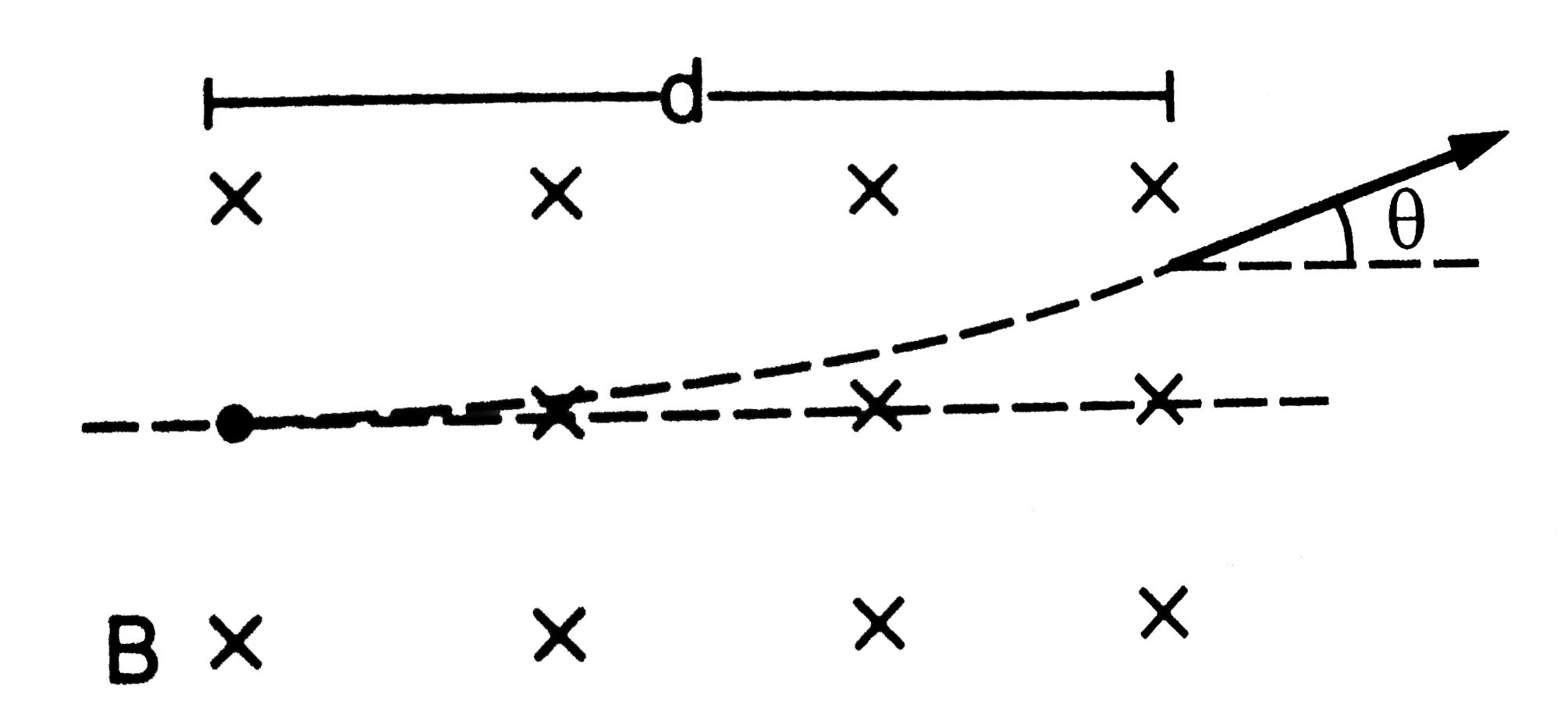A charged particle (q,m) enters perpendicular in a uniform magnetic field B and comes out field as shown. Find the angle of deviation θ for particle to cross magnetic field will be
 Solution in Tamil
Solution in Tamil
Mass of the particle =m .
char≥=q,
wh=d,
(a ) If d=mVqb
then d is equal the radius q is the angle between the radius and tangent which is equal to π2
(b ) if d=distancetravel≤d ,
12 of radius along x- distance
d=V0r
i, e, i=dVx .....(1)
vy=uy+ryl
From (i) putting the value of i,
tansinθ=12
⇒sinθ=tan−1(12)
=26.4=30∘=π6
(c ) The angle between the initial direction and final direction of velocity is π .
Topper's Solved these Questions
Similar Questions
If a charged particle at rest experiences no electromagnetic force, then electric field in that region
View SolutionFind the range of frequency of light that is visible to an average human being (400nm<λ<700nm)
View SolutionUsing the formulae ((→F)=(→qv)×(→B)andB=(μ0)i2πr,find the SI units of the magnetic field B and the permeability constant
View SolutionA charged particle enters a uniform magnetic field with velocity v_(0) = 4 m//s perpendicular to it, the length of magnetic field is x = ((sqrt(3))/(2)) R , where R is the radius of the circular path of the particle in the field. Find the magnitude of charge in velocity (in m/s) of the particle when it comes out of the field.
View SolutionA particle having mass m , charge q enters a cylindrical region having uniform magnetic field B in the inward direction as shown. If the particle is deviated by 60^(@) as it emerges out of the field then what is the time spent by it in the field?
View SolutionA charged particle enters a uniform magnetic field perpendicular to it. The magnetic field
View SolutionA charged particle (q, m) enters perpendicular in a uniform magnetic field B and comes out field as shown. The angle of deviation theta time taken by particle to cross magnetic field will be
View SolutionA charge particle of charge 'q' and mass 'm' enters in a given magnetic field 'B' and perpendicular to the magnetic field as shown in the figure. It enters at an angle of 60^(@) with the boundary surface of magnetic field and comes out at an angle of 30^(@) with the boundary surface of the magnetic field as shown in the figure. Find width 'd' in which magnetic field exist.
View SolutionA positive charge particle of charge q, mass m enters into a uniform magnetic field with velocity v as shown in the figure. There is no magnetic field to the left of PQ. Find distance travelled in the magnetic field
View SolutionIf a charged particle enters perpendicular in the uniform magnetic field then
View Solutionएक आवेशित कण, चुम्बकीय क्षेत्र रेखाओं के साथ 85∘ का कोण बनाते हुए एकसमान चुम्बकीय क्षेत्र में प्रवेश करता है। कण का पथ एक वृत्त है।
View SolutionA charged particle of charge q and mass m is shot into a uniform magnetic field of induction B at an angle θ with the field. The frequency of revolution of the particle
View Solutionद्रव्यमान m व आवेश q का एक कण एक समान चुम्बकीय क्षेत्र में v वेग से क्षेत्र की दिशा के लम्बवत् प्रवेश करता है। कण का घूर्णन काल
View SolutionA charge particle of charge 'q' and mass 'm' enters in a given magnetic field 'B' and perpendicular to the magnetic field as shown in the figure. It enters at an angle of 60^(@) with the boundary surface of magnetic field and comes out at an angle of 30^(@) with the boundary surface of the magnetic field as shown in the figure. Find width 'd' in which magnetic field exist.
View SolutionA particle of mass m and charge q is projected into a region having a perpendicular magnetic field B. Find the angle of deviation fo the particle as it comes out of the magnetic field if the width d of the regions is very smaller then

View SolutionA charged particle enters a uniform magnetic field with velocity v0=4m/s perpendicular to it, the length of magnetic field is x=(√32)R, where R is the radius of the circular path of the particle in the field. Find the magnitude of charge in velocity (in m/s) of the particle when it comes out of the field.
View Solution